Related Research Articles

A coin is a small, flat, round piece of metal or plastic used primarily as a medium of exchange or legal tender. They are standardized in weight, and produced in large quantities at a mint in order to facilitate trade. They are most often issued by a government. Coins often have images, numerals, or text on them. Obverse and its opposite, reverse, refer to the two flat faces of coins and medals. In this usage, obverse means the front face of the object and reverse means the back face. The obverse of a coin is commonly called heads, because it often depicts the head of a prominent person, and the reverse tails.

The Napoléon is the colloquial term for a former French gold coin. The coins were minted in denominations of 5, 10, 20, 40, 50, and 100 francs. This article focuses on the 20 franc coins issued during the reign of Napoléon Bonaparte, which are 21 mm in diameter, weigh 6.45 grams and, at 90% pure, contain 0.1867 troy ounces (5.807 g) of pure gold. The coin was issued during the reign of Napoleon I and features his portrait on the obverse. The denomination continued in use through the 19th century and later French gold coins in the same denomination were generally referred to as "Napoléons". Earlier French gold coins are referred to as Louis or écu. Gold Napoléons have historically proven more resilient than other gold coins to economic forces, such as after the Suez crisis when unlike other coins Napoléons did not weaken.
The Latin Monetary Union (LMU) was a 19th-century system that unified several European currencies into a single currency that could be used in all member states when most national currencies were still made out of gold and silver. It was established in 1865 and disbanded in 1927. Many countries minted coins according to the LMU standard even though they did not formally accede to the LMU treaty.

Benedetto Pistrucci was an Italian gem-engraver, medallist and coin engraver, probably best known for his Saint George and the Dragon design for the British sovereign coin. Pistrucci was commissioned by the British government to create the large Waterloo Medal, a project which took him thirty years to complete.
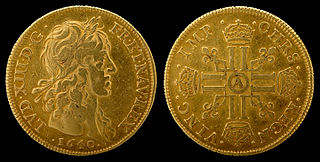
The Louis d'or is any number of French coins first introduced by Louis XIII in 1640. The name derives from the depiction of the portrait of King Louis on one side of the coin; the French royal coat of arms is on the reverse. The coin was replaced by the French franc at the time of the revolution and later the similarly valued Napoléon. The actual value of the coins fluctuated according to monetary and fiscal policy, but in 1726 the value was stabilized.

A medal or medallion is a small portable artistic object, a thin disc, normally of metal, carrying a design, usually on both sides. They typically have a commemorative purpose of some kind, and many are given as awards. They may be intended to be worn, suspended from clothing or jewellery in some way. They may be struck like a coin by dies or die-cast in a mould.
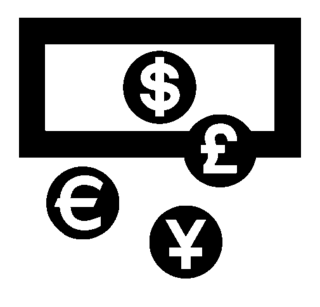
A mint is an industrial facility which manufactures coins that can be used as currency.

The franc, also commonly distinguished as the French franc (FF), was a currency of France. Between 1360 and 1641, it was the name of coins worth 1 livre tournois and it remained in common parlance as a term for this amount of money. It was reintroduced in 1795. After two centuries of inflation, it was redenominated in 1960, with each new franc (NF) being worth 100 old francs. The NF designation was continued for a few years before the currency returned to being simply the franc. Many French residents, though, continued to quote prices of especially expensive items in terms of the old franc, up to and even after the introduction of the euro in 2002. The French franc was a commonly held international reserve currency of reference in the 19th and 20th centuries.

The ducat coin was used as a trade coin in Europe from the later Middle Ages from the 13th to 19th centuries. Its most familiar version, the gold ducat or sequin containing around 3.5 grams of 98.6% fine gold, originated in Venice in 1284 and gained wide international acceptance over the centuries. Similarly named silver ducatons also existed. The gold ducat circulated along with the Florentine florin and preceded the modern British pound sterling and the United States dollar.

The Empire style is an early-nineteenth-century design movement in architecture, furniture, other decorative arts, and the visual arts, representing the second phase of Neoclassicism. It flourished between 1800 and 1815 during the Consulate and the First French Empire periods, although its life span lasted until the late-1820s. From France it spread into much of Europe and the United States.

A pattern coin is a coin which has not been approved for release, but produced to evaluate a proposed coin design. They are often off-metal strike, to proof standard or piedforts. Many coin collectors collect and study pattern coins because of their historical importance. Many of the world's most valuable coins are pattern coins; nearly 25 of the pieces listed in 100 Greatest US Coins are pattern coins.

This glossary of numismatics is a list of definitions of terms and concepts relevant to numismatics and coin collecting, as well as sub-fields and related disciplines, with concise explanations for the beginner or professional.

The real was the unit of currency of Portugal and the Portuguese Empire from around 1430 until 1911. It replaced the dinheiro at the rate of 1 real = 840 dinheiros and was itself replaced by the escudo at a rate of 1 escudo = 1000 réis. The escudo was further replaced by the euro at a rate of 1 euro = 200.482 escudos in 2002.
A mint mark is a letter, symbol or an inscription on a coin indicating the mint where the coin was produced. It should not be confused with a mintmaster mark which is the mark of the mintmaster.
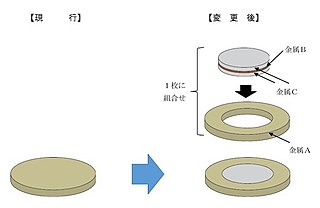
Bi-metallic coins are coins consisting of two (bi-) metals or alloys, generally arranged with an outer ring around a contrasting center. Common circulating examples include the €1, €2, United Kingdom £1 and £2, Canadian $2, South Africa R5, Turkish 1 lira and 50 kurus, Indian ₹10 and ₹20, IDR 1K, 2 and 5 PLN, 50 CZK, 100 and 200 HUF, 1 and 2 BGN, Hong Kong $10, Argentine $1 and $2, Brazilian R$1, Chilean $100 and $500, Colombian $500 and $1000, and all Mexican coins of $1 or higher denomination.
The Papal Mint is the pope's institute for the production of hard cash. Papal Mint also refers to the buildings in Avignon, Rome, and elsewhere that used to house the mint..
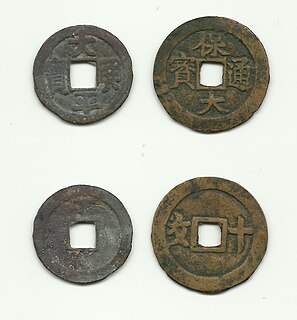
Vietnamese cash is a cast round coin with a square hole that was an official currency of Vietnam from the Đinh dynasty in 970 until the Nguyễn dynasty in 1945, and remained in circulation in North Vietnam until 1948. The same type of currency circulated in China, Japan, Korea, and Ryūkyū for centuries. Though the majority of Vietnamese cash coins throughout history were copper coins, lead, iron and zinc coins also circulated alongside them often at fluctuating rates. Coins made from metals of lower intrinsic value were introduced because of various superstitions involving Vietnamese people burying cash coins, as the problem of people burying cash coins became too much for the government. Almost all coins issued by government mints tended to be buried mere months after they had entered circulation. The Vietnamese government began issuing coins made from an alloy of zinc, lead, and tin. As these cash coins tended to be very fragile, they would decompose faster if buried, which caused the Vietnamese people to stop burying their coins.

During his rise to power and throughout his reign, Napoleon not only benefitted from circumstance but also cultivated his own image through the use of propaganda. Napoleon excelled at garnering public support and capitalizing on his victories to convey a persona associated with success and heroism. He utilized propaganda in a wide range of media including theater, art, newspapers and bulletins to “promote the precise image he desired.” Napoleon’s bulletins from the battlefield were published in newspapers and were well read throughout the country. He used these publications to exaggerate his victories and spread his glorified interpretation of these successes throughout France.

The Great Recoinage of 1816 was an attempt by the government of the United Kingdom of Great Britain and Ireland to re-stabilise its currency, the pound sterling, after the economic difficulties brought by the French Revolutionary Wars and the Napoleonic Wars.
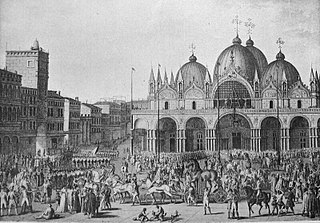
The Napoleonic looting of art was a series of confiscations of artworks and precious objects carried out by the French army or French officials in the territories of the First French Empire, including the Italian peninsula, Spain, Portugal, the Low Countries, and Central Europe. The looting continued for nearly 20 years, from 1797 to the Congress of Vienna in 1815.